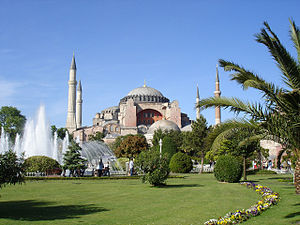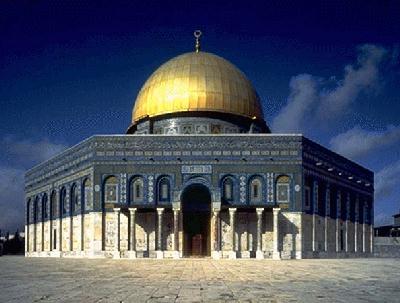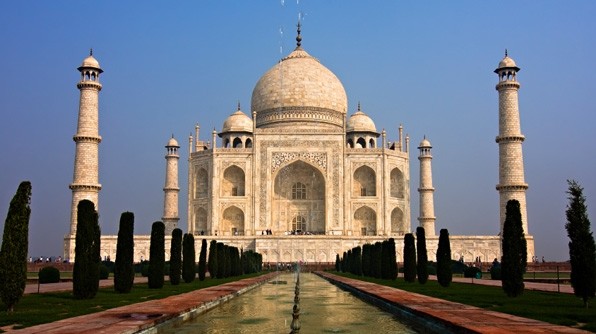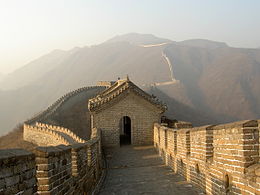

Hagia Sophia is the most important church in Istanbul. It was designed by Anthemius of Tralles and Isidorus of Miletus in 532. At that time, Justinian reigned over Byzantine Empire. The style of this church is clearly Byzantine. This church is 270 feet long and 240 feet wide. Its dome is 108 feet in diametre and rises 108 feet above the pavement. Across its history, this building has been an Orthodox church, a Catholic church, and a mosque. It has been a museum since 1931. It originally replaced the "Great Church", which had been erected in 360. The plan of the building is rectangular and divided into one nave and two aisles. They are divided by arches supported by granite piers. A group of women's galleries are placed on the nave. There is also a polygonal apse. A double narthex precedes the gate of the former church. The dome of this church is the second greatest one of the world. It is slightly helliptical. Many typical Byzantine mosaics are placed on the walls. The windows of the church, which are placed on the base of the dome, filter light. A group of pendentives create the impression of a dome suspended in the sky.

The Dome of the Rock is the most important sanctuary in Jerusalem. It was erected between 687 and 692. At that time, Jerusalem was an Islamic city governed by the Umayyad sultan. The platform on which the sanctuary was erected was called "The noble fence". It was the same site where the temple of Solomon was once placed. Here, Adam died, Isaac was sacrfied, and Mohammed reached Heaven before going back to Earth. The sanctuary celebrated the triumph of Islam over the other religions, but it could be meant as a point of contact among the religions represented themselves. The building is divided into five main elements: a gateway, the mausoleum itself, a mosque, a garden divided into four parts, and a "house for guests". In the garden, are flowerbeds and water channels. The plan of the building is octagonal. Its double-shelled wooden dome is 60 feet wide and 75 feet high. The mosaics on its walls remind Graeco-Roman and Byzantine ones. The building also has four gateways. Everyone is surmounted by its own lintel.Inside, are two octagonal concentrical fences.

Taj Mahal is a sanctuary erected in Agra between 1632 and 1647. At that time, India was reigned by Shah Jahan. The building is the mausoleum of his favourite wife, Mumtaz Mahal. Taj Mahal mixes Hinduist, Buddhist, and Islamic motiffs. The building is cubic and made of white marble, but the inner plan is octagonal. The niches outside are arcuated and remind Iranian architecture. The dome of the building is shaped like a crown. Four minarets are placed on the corners of its courtyard, and two domed pavillions are placed near the main dome. Taj Mahal is a metaphor of the throne of God over the gardens of Heaven.

The Great Wall of China originally had a defensive role because it was used to defend China from foreign attacks, such as those of Mongolians. The Great Wall started to be erected in 215 BC. At that time, Qin Shi Huangdi was the Chinese emperor. The Wall crosses the Wall crosses the whole Chinese land. It is 21000 kilometres long, but it is less than 10 metres wide. As a result, differing from what a famous legend tells, it is not visible from the moon.

The Petronas Twin Towers (or Menara Towers) are the most important buildings in Kuala Lampur. They were designed by architect Cesar Pelli between 1995 and 1998 and reamined the highest building into the world between 1998 and 2004. They are 452 metres high and have an 88-storeyed fašade. These towers are the symbols of economic progress in Malaysia and have 32000 windows on their fašade. Their plan follows an Islamic pattern because it is composed of two overlapped squares creating a star inscribed by a circle. These shapes symbolize harmony, rationality, and stability.

Borobudur is a Buddhist monument. It was erected in Java in 800. Its base measures 400 feet per side, and its fašade is 98 feet tall. The structure is mainly made of volcanic stone and is composed of nine terraces accessed by stairways. There are 1000 panels and 1500 stupas. The former represent: the effects of human behaviour, scenes from Buddha's life, and scenes from Shakyamuni's life. Each stupa holds a Buddha's statue. Here, Buddha is spiritually enlightened and prays turning his wheel.